A Universal Power Sensor
Anritsu Co.
Morgan Hill, CA
Power is a fundamental measurement that has been made by RF engineers since the first days of radio transceivers. The basic theory of accurate power measurements has not changed since that time as thermal absorption and diode rectification remain the foundation of all power measurements. These two technologies have satisfied the industry’s requirement to perform measurements on CW signals or carriers with relatively narrowband modulation schemes. The introduction of wide bandwidth modulation schemes including CDMA, high definition television, direct audio broadcasting and satellite communications has made such traditional sensor technologies inadequate. As a result, a new universal sensor that integrates a patented architecture has been developed to overcome the limitations of previous-generation sensors and allow for highly accurate power measurements on wide bandwidth signals.
Sensor Performance
Designed for use with the ML2400A and ML2430A power meter series, the model MA2481A universal power sensor has a conventional diode sensor’s fast response time and low power sensitivity as well as a wider dynamic range for true RMS detecting. The conventional diode detector has a low level sensitivity of -70 dBm, and a diode sensor operating in true RMS mode has 50 dB of dynamic range. The universal power sensor increases the 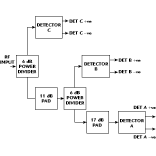 overall sensor dynamic range to 80 dB by combining three separate diode detection elements into a single sensor. The power at a given input that each element detects in relation to the sensor input power varies, and the element with the maximum detection voltage is selected to be used for a given input power. Simultaneously, the appropriate element is maintained within its square-law region of operation. Figure 1 shows the universal power sensor’s block diagram.
overall sensor dynamic range to 80 dB by combining three separate diode detection elements into a single sensor. The power at a given input that each element detects in relation to the sensor input power varies, and the element with the maximum detection voltage is selected to be used for a given input power. Simultaneously, the appropriate element is maintained within its square-law region of operation. Figure 1 shows the universal power sensor’s block diagram.
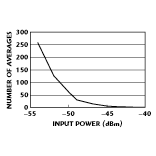 The new sensor has been designed to have improved dynamic range overall despite the fact that each of the three elements has a 50 dB individual range. Although a diode element detects very accurately over its 50 dB dynamic range, the detected voltage at the lower 10 dB power levels approaches the noise level. Even at the diode element’s lower 30 dB power levels, measurement averaging is required to accurately pick out the detected voltage from random noise voltage. This averaging significantly impacts measurement speed, as shown in Figures 2 and 3 .
The new sensor has been designed to have improved dynamic range overall despite the fact that each of the three elements has a 50 dB individual range. Although a diode element detects very accurately over its 50 dB dynamic range, the detected voltage at the lower 10 dB power levels approaches the noise level. Even at the diode element’s lower 30 dB power levels, measurement averaging is required to accurately pick out the detected voltage from random noise voltage. This averaging significantly impacts measurement speed, as shown in Figures 2 and 3 .
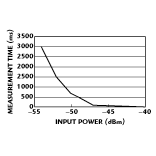 The universal power sensor’s first element covers the +20 to -3 dBm power input range, the second element covers -3 to -20 dBm and the third element covers -20 to -60 dBm. While the power meter will slow down when the input power falls below -45 dBm (due to the laws of physics), it excels at -3 to -20 dBm (the power range where most engineers and product personnel conduct the majority of their measurements). At this middle power range, the three-element universal sensor is much faster, easier and more accurate than competitive solutions. Figure 4 shows measurement speed as it relates to the input power of a two-element power sensor. In contrast, the three-element universal sensor requires < 20 ms per measurement with < 0.05 dB of reading fluctuation.
The universal power sensor’s first element covers the +20 to -3 dBm power input range, the second element covers -3 to -20 dBm and the third element covers -20 to -60 dBm. While the power meter will slow down when the input power falls below -45 dBm (due to the laws of physics), it excels at -3 to -20 dBm (the power range where most engineers and product personnel conduct the majority of their measurements). At this middle power range, the three-element universal sensor is much faster, easier and more accurate than competitive solutions. Figure 4 shows measurement speed as it relates to the input power of a two-element power sensor. In contrast, the three-element universal sensor requires < 20 ms per measurement with < 0.05 dB of reading fluctuation.
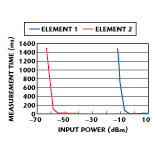 At +13 dBm input to the sensor, element 1 begins to leave square law and enter the transition detection region. The transition region of the diode changes slowly and the deviation from square law is < 0.1 dB over a 10 dB range. This small deviation can be easily corrected without adversely affecting the true RMS accuracy. On the other hand, the crossovers of element 1 to element 2 and element 2 to element 3 were made so that large square law overlaps exist between the crossover elements.
At +13 dBm input to the sensor, element 1 begins to leave square law and enter the transition detection region. The transition region of the diode changes slowly and the deviation from square law is < 0.1 dB over a 10 dB range. This small deviation can be easily corrected without adversely affecting the true RMS accuracy. On the other hand, the crossovers of element 1 to element 2 and element 2 to element 3 were made so that large square law overlaps exist between the crossover elements.
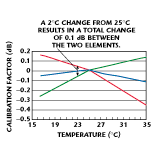 Since wideband CDMA (W-CDMA) can have a 14 dB crest factor, the extended square law overlap in the universal power sensor ensures that the ever-changing power peaks and troughs of W-CDMA are detected accurately in square law and integrated, resulting in an accurate average power measurement. The sensor will accurately measure even wider-bandwidth signals as they become required by the next modulation standard or even dual-tone signals.
Since wideband CDMA (W-CDMA) can have a 14 dB crest factor, the extended square law overlap in the universal power sensor ensures that the ever-changing power peaks and troughs of W-CDMA are detected accurately in square law and integrated, resulting in an accurate average power measurement. The sensor will accurately measure even wider-bandwidth signals as they become required by the next modulation standard or even dual-tone signals.
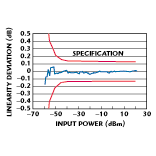 The greatest challenge in achieving sensor linearity is to have the three elements operate seamlessly without discontinuity in the linearity curve. Each diode element has its own temperature and frequency characteristics. The universal power sensor/meter has extremely accurate built-in temperature correction. The importance of the temperature correction error is evidenced by the fact that if the temperature correction error is as little as 2°C, a linearity discontinuity of 0.1 dB can occur. Figure 5 shows the temperature characteristics of three diode elements.
The greatest challenge in achieving sensor linearity is to have the three elements operate seamlessly without discontinuity in the linearity curve. Each diode element has its own temperature and frequency characteristics. The universal power sensor/meter has extremely accurate built-in temperature correction. The importance of the temperature correction error is evidenced by the fact that if the temperature correction error is as little as 2°C, a linearity discontinuity of 0.1 dB can occur. Figure 5 shows the temperature characteristics of three diode elements.
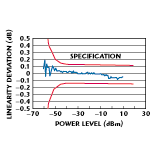 With proper frequency and temperature characterization, the universal power sensor has a CW, W-CDMA and dual-tone linearity of better than three percent, as shown in Figures 6, 7 and 8 . Table 1 lists the specifications for the sensor. Because the universal power sensor already has the same hardware as a regular diode sensor, the least attenuated element of the sensor is fully characterized and data stored in the sensor’s electronically erasable programmable read-only memory are similar to data from a standard diode sensor. When the power meter is switched to a CW measurement mode, CW signal power can be measured with the speed and accuracy of a standard diode sensor.
With proper frequency and temperature characterization, the universal power sensor has a CW, W-CDMA and dual-tone linearity of better than three percent, as shown in Figures 6, 7 and 8 . Table 1 lists the specifications for the sensor. Because the universal power sensor already has the same hardware as a regular diode sensor, the least attenuated element of the sensor is fully characterized and data stored in the sensor’s electronically erasable programmable read-only memory are similar to data from a standard diode sensor. When the power meter is switched to a CW measurement mode, CW signal power can be measured with the speed and accuracy of a standard diode sensor.
|
Table 1 |
| |
|
Frequency range |
10 MHz to 6 GHz |
|
|
Dynamic range (dBm) |
-60 to +20 |
|
|
SWR |
|
|
|
10 to 50 MHz |
<1.90 |
|
|
50 to 150 MHz |
<1.17 |
|
|
0.15 to 2 GHz |
<1.12 |
|
|
2 to 6 GHz |
<1.22 |
|
|
Linearity (%) |
<3 | |
Conclusion
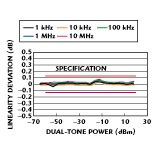 A new power meter sensor is now available that combines the accuracy of a thermal sensor with the speed of a diode sensor while delivering more than 80 dB of dynamic range. The model MA2481A universal power sensor features a patented technology that permits fast and accurate measurement of complex modulated signals over a wide operating region. This new technology may render previous power measurement methods obsolete. Contact the company for price and availability information.
A new power meter sensor is now available that combines the accuracy of a thermal sensor with the speed of a diode sensor while delivering more than 80 dB of dynamic range. The model MA2481A universal power sensor features a patented technology that permits fast and accurate measurement of complex modulated signals over a wide operating region. This new technology may render previous power measurement methods obsolete. Contact the company for price and availability information.
Anritsu Co., Morgan Hill, CA (800) 267-4878.
